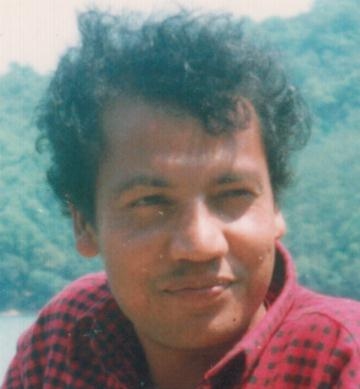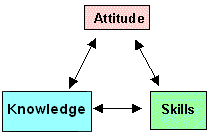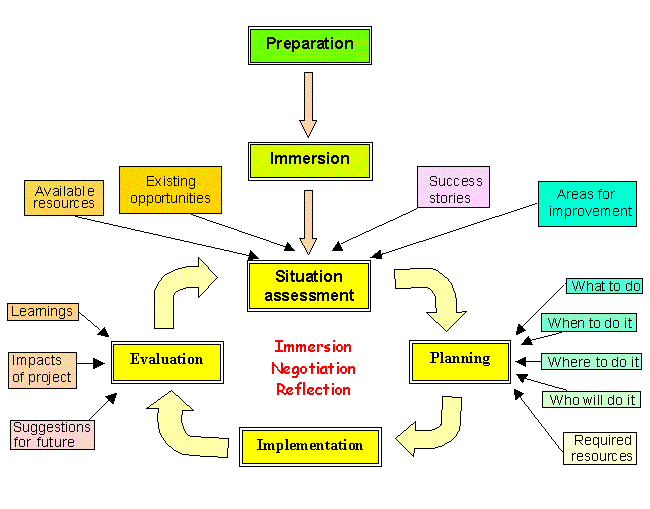Tweet
Translations:
'العربية / al-ʿarabīyah
Català
English
Español
Filipino/Tagalog
Français
Ελληνικά / Elliniká
Italiano
日本語 / Nihongo
Português
Română
Српски / Srpski
Tiếng Việt
Türkçe
Other Pages:
Modules
Site Map
Key Words
Contact
Utility Documents
Useful Links
This paper was presented in the
"International Workshop on Action Learning: Lessons from the Field" in October 2004
organised by the Faculty of Policy Studies, Chuo University, Tokyo, Japan
 |
Sharing some practical experiences on
Participatory Appreciative Planning Approach [PAPA]
An appreciative approach to working in partnership with community people
by Kamal Phuyal, PhD
edited by Phil Bartle, PhD
My name is Kamal Phuyal. I have been involved in development field since 1987. I started development work as a 'community facilitator' in a remote village of Nepal. Since then, I have been working in various parts of Nepal, mostly rural areas, through various government and non-governmental organisations. I believe in the need of people's participation, and ultimately their leadership, for sustainable development. I, therefore, learnt PRA, PLA and some other participatory approaches and have been applying these methods in my work since 1990. For last five years and more, I have been applying participatory appreciative planning approach, which concentrates more on the positive strengths of the community and develop development plans being based on that. I have experienced/realised this approach becoming more effective and a good mean to work together with the local people for change. Here, I would like to share some of my practical working experiences with you.
1. PAPA: an appreciative approach
1.1 What is PAPA?
Participatory Appreciative Planning Approach (PAPA) was initiated in Nepal after 1999 and widely used by various organisations and individuals. However, different people and organisations use different name such as positive planning approach, appreciative planning approach, etc. This approach shares the values raised by 'appreciative inquiry (AI)' approach.
People-centeredness has been one of the major components of this approach which advocates "people's participation in the development process" as their rights. It is local people's rights to analyse their own situation and to plan for the better future. Local people, preferably marginalized people, should have control over the decisions made regarding 'development' which affects their lives and conditions. For this, outsiders listen to the local people, learn from the local people and work together with the local people as the facilitators. Thus, this approach highlights participation as "development organisations should participate in community's issues - not that community participate in organisations' set agendas."
Other major contribution of PAPA to the participatory approach is that it advocates the importance of positive strengths of the community that lead to sustainable development. It discourages to concentrate or initiate discussion on the problems of the community, which normally creates frustration and inferiority among the people. "We have problems a lot - we have difficulties" kind of thoughts among the people cannot initiate empowerment process. PAPA, therefore, always starts sharing among the people with their existing strengths, success stories, availability of local resources, and indigenous knowledge/practices. It rather prefers to use the term 'areas for improvement' than problems.
This approach shares the following basic ideas:
- Local people know about their situation much better than outsiders. They, therefore, should lead the development process.
- It is people's rights to analyse their situation, think and plan for the better future, implement the action and evaluate its results.
- Respect diversities. Different people (from different economic class, different caste group, etc.) have different ideas, different needs, and different desires. Facilitators must respect it and listen to all to learn the realities.
- Listen to, learn from and support the local people, preferably the marginalized people.
- Respect indigenous knowledge and practices. Learn from that.
- Development process must be simple and fun so that even illiterate people can participate easily.
1.2 PAPA process
PAPA follows its implementation process as follows:
 |
Regarding the implementation stages, it mainly follows the steps of 'participatory project cycle' which has been included in annex 1. The detailed explanation of each step of PAPA has been included in annex 2.
1.3 Why PAPA?
The important aspects of PAPA I have experienced/realised from various practices in different community are such as follows:
- It is based on the positive strengths of the local people rather than problems and weaknesses existing in the community. As Mac Odell says - "if you look for problems, you find more problems; if you look for successes, you find more success. If you believe in your dreams you can accomplish miracles." We, therefore, always concentrate more on finding the root causes of the success rather than focussing only on root causes of the problems.
- Positive environment: Paying attention to the positive aspect always creates a happy environment. People's faces turn bright and they feel "we have a lot of good things, we can do much better than now" by ourselves during its exercise.
- Always listen to the local people and encourage them to express and share their ideas with others. Preference is given to listening to the marginalized people so as to learn their realities. As the process is simple, fun, and positive, marginalized people get excited to participate by sharing their ideas and feelings. Especially in Nepal's case, economically poor and so-called low caste people are the most vulnerable ones (see annex 3 to understand marginalisation in Nepalese society).
- Local people set their dreams to change the community being based on their socio-cultural context as PAPA always encourage local people to set the dreams (or development goals), not to follow the dreams set by outsiders.
- Use of local resources: when we carry on the PAPA process, people focus more on the existing resources of the community. They, therefore, first discuss to utilise the local resources for the development of the community rather than demanding and demanding funds from outside (donors). Thus, the real empowerment process begins.
- Change the mindset of the 'development facilitators': when development facilitators see the strengths of local people, both in terms of their capabilities and the richness of local resources, they realise the importance of participatory approach.
1.4 Tools to be used
Various participatory tools, mainly PRA/PLA tools, are used in order to conduct PAPA exercises. These tools are used mainly to enable local people to express and share information, and to stimulate discussion and analysis. Many are visually based, involving local people in creativity. People (in rural context) use local materials, such as sticks, stones, grasses, wood, tree leaves, and soils. They are not familiar with paper and pens. For villagers it can be quite different: "villagers' hands shake when they hold a pen, and when they get to the edge of the paper, they're finished". Some of the following tools can be used:
- Social mapping
- Resource mapping
- Transect walk
- Pair-wise ranking
- Drawing, etc.
(See annex 4 for the brief explanations of these tools)
3. PAPA facilitator
Role of the facilitators is vital to carry on the process successfully. Facilitators normally work to make the process easier and create conducive environment to encourage local people to participate in the process.
Participation of the marginalized people, mainly of those who are illiterate and who hesitate to speak out, is impossible if facilitation is not appropriate. The success of the exercises mainly depends on facilitators acting as convenors and catalysts, but without dominating the process. They must take time, show respect, be open and self-critical, and learn not to interrupt. Facilitator, thus, must have adequate skills to enhance the level of participation (see annex 5 for level of participation in the workshops). Now a question comes up here that what qualities are necessary to be a facilitator.
 |
I think the combination of three major aspects is very important to be a good and able facilitator: attitude, knowledge, and skills. However, attitude plays the vital role for the successful facilitation, mostly in PAPA exercises. Some of the major necessary qualities to be a facilitator, from my experience, as follows:
| Attitudes | Positive thinking Believe in people's capabilities, of course of the marginalized people Listening and respecting others' ideas Commitment to social change Gender sensitivity Respect to local cultures Open minded Enjoy challenges and unwanted difficulties High learning attitude |
| Knowledge | Comprehensive understanding of development Participatory approach Rights-based approach Social power structure Conflict management Project management |
| Skills | Communication/listening Body language Using participatory tools and techniques Group mobilisation Social analysis Participatory research Negotiation Writing/documentation Conflict management Leadership Using exercises, role-plays, games, energizers Facilitation skills |
We all have experiences in our field. So, let's share to find out how these qualities can be up graded.
4. At the end
PAPA is not everything. It has limitations. It has been found effective in the micro level, however, difficult to use in big area.
PAPA is not a magical package that has suddenly appeared from nowhere. It has been developed in the course of working together with the rural people in Nepal; however, it is used in urban communities and in various institutions as well.
PAPA is for community - community is not for this approach.
Only a good human being can be a good facilitator. The values of PAPA, therefore, should be incorporated in one's living.
Annex 1: Participatory project cycle
PAPA process is derived from participatory project cycle.
 |
Compare with the Mobilization Cycle.
Annex 2: PAPA steps
| [Situation assessment] Finding good things and areas for improvements |
|
| Setting the dreams for change |
|
| Designing necessary activities to materialize the dreams |
|
| Developing detailed implementation plan |
|
Detailed implementation plan format (an example)
[Widen these columns and turn the table to horizontal]
|
process |
area |
Date | Required materials |
|
Potential challenges to be faced | Suggestions to deal with challenges | ||
| Community | Local government | Others | ||||||
|
|
Annex 3: Some examples of the participatory tools that can be used for PAPA exercise Social map: In most heterogeneous societies a number of caste, ethnicity, social and economic groups are there. It is important to understand the stratification of the communities both in terms of resource and their access and distribution. Understanding on social structure in community is crucial in order to carry on the development activities that aim the empowerment of marginalized section. Social map tool can be better for this analysis. Moreover, it can generate various information; household number, population size, literacy number, cattle number and etc. Initially a general introduction of the objectives of the exercise must be given. Then the villagers should be encouraged to draw the map of the village. In order to encourage, the facilitator should initiate first to draw. Then every effort must be given to hand over the stick, the map usually is drawn in the common ground using local materials for representation as much as possible. This ensures interest and encourages participation of the community. Constant effort must be given to get women and children's perspective or separate map can be drawn as well. Resource map: This tool indicates existing natural resources in the village including the land and water resources. The uses of these resources and accessibility of the poor people to these resources are also analysed. Resource map also shows the quality or status of each resource. These maps help in identifying and inventorying various types of resources in the village and their characteristics in the initial stages of the development process itself. This process of mapping ensures that all kinds of diversities are taken into account during further discussion with the local people. Transect walk: This is a systematic walk with the local people of the community observing, asking, listening, looking, identifying different zones, seeking opportunities and areas for improvements. The findings can be shown in social map or on a transect diagram. The outsider facilitators have a walk around the village. Outsiders ask questions and learn from the villagers about the local situation. The outsiders can set the checklist to share and learn from the local people before initiating the transect walk. Better to follow the 'U' shape for walk in order to have deeper understanding about the area. Pair-wise ranking: This tool confirms local people's categories, criteria, choices and priorities. The major reasons of preferences are derived which than can be again scored basing on a single indicator progression. It helps to prioritize the areas for improvements as well as projects. For pair wise ranking items of interest are compared pair by pair, informants being asked which is preferred of the two, and why. Matrix ranking and scoring takes criteria for the rows in a matrix and items for columns, and people fill in the boxes for each row. Annex 4: Existing marginalisation situation in Nepalese social structure
Annex 5: Level of participation in 'participatory workshops'
Endnotes:
Also see: Sharing Happiness With PRA, by Kamal Phuyal
––»«––© Copyright 1967, 1987, 2007 Phil Bartle
––»«–– |
Home page |
Community Empowerment |